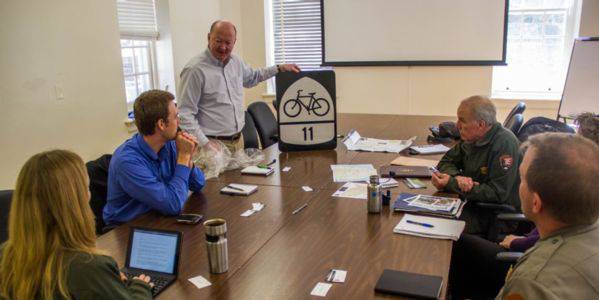
Determine Team & Stakeholders
State departments of transportation (DOTs) are ultimately responsible for supporting and overseeing U.S. Bicycle Routes with their state; however DOTs may delegate the legwork to external partners. DOTs that do not have the capacity to pursue implementation directly can partner/contract with non-government organizations, stakeholder organizations, and volunteers. Refer to the case studies in the Best Practice Report in the Implementation Resources for examples of different models used by states to achieve implementation.
DOTs may consider collaborating with these types of organizations:
- Statewide or local coalitions or advocacy groups
- Governor-appointed or statewide bicycle and pedestrian advisory councils or boards
- Transportation consultants
- Tourism and economic development organizations
- Parks agencies or departments of natural resources
- DOT districts, Metropolitan Planning Organizations (MPOs), councils of government, road commissions, and others
Adventure Cycling provides training and technical assistance to work through the implementation process with agency staff and partners. Contact usbrsinfo@adventurecycling.org to learn more.
Establish Timeline & Team Communications
Establish a timeline that will help meet your desired application deadline. AASHTO approves new U.S. Bicycle Routes only two times per year, at the spring and fall meetings. Applications for designation are due approximately 5-6 weeks prior to those meetings. To complete all tasks for a particular application deadline, assign dates and responsibilities against that goal. Experience teaches that delays can easily occur throughout the process, so we recommend adding a buffer to your timeline
Communication can be achieved through in-person meetings, conference calls, web conferences, emails, or Google Groups. Adventure Cycling can assist with the coordination of these meetings.
Determine Route Evaluation Method
The National Corridor Plan provides a starting point for choosing where to develop a U.S. Bicycle Route. Corridors can be adjusted or added within a state to take advantage of existing or emerging bicycle infrastructure or other routing opportunities.
- A state can change a corridor's alignment as needed if it does not impact the connections to neighboring states.
- If different connection point(s) are needed, then the affected neighboring state(s) will need to be contacted in order to determine an agreed upon connection point(s).
- The AASHTO Multimodal Task Force will provide oversight to this process. Please contact usbrsinfo@adventurecycling.org to inquire about adding or changing a corridor.
Once a corridor is chosen, determine the method for defining and evaluating the route. DOTs are encouraged to develop their own route selection criteria and internal processes to ensure that U.S. Bicycle Route designation meets the standards of DOT management. See the Implementation Resources page for links to sample criteria and roadway evaluation methods.
Next Steps: Designation
The designation process begins next, which includes:
- Drafting the Route
- Securing Local Agreements along the Route
- Preparing and Submitting the AASHTO Application